Effect of Silicon on Thermal Stability of 4Cr3Mo2V Hot-Work Die Steel
Abstract
:1. Introduction
2. Materials and Methods
3. Results
3.1. Effects of Tempering Temperature and Time on Hardness
3.2. Effects of Tempering Temperature on Hardness
3.3. Analysis of Microstructural Evolution Mechanism
4. Discussion
4.1. Effects of Precipitates on Properties of Steel during Thermal Stabilization
4.2. Thermodynamics of Precipitation
5. Conclusions
- During the thermal stability experiment, the 1.0 Si steel sample always has higher hardness than the 0.3 Si steel sample. The hardness of the 1.0 Si steel sample is 2.0 HRC greater than that of the 0.3 Si steel sample after being held at 600 °C for 64 h. The former is 4.1 HRC greater than the latter one after being held at 650 °C for 64 h. Thus, the thermal stability of the 1.0 Si steel sample is better than that of the 0.3 Si steel sample;
- The two tested steel samples are insulated at 650 °C. With the extension of holding time, the matrix structure gradually recovers, the characteristics of the martensitic lath are weakened and the number of carbides increases. After being held at constant temperature for 64 h, the percentage of carbides with a size of 1–100 nm in the 1.0 Si steel matrix is 34% greater than that of the 0.3 Si steel sample, and the percentage of carbides with a size of 200–400 nm is 30% greater than that of the 0.3 Si steel sample;
- After being tempered at 650 °C, Mo-rich M6C-type carbide particles in the 0.3 Si steel sample show an obvious aggregation and growth phenomenon. In addition, Si hinders carbon atomic diffusion and inhibits M6C roughening, making the average particle size in the 1.0 Si steel sample small. Additionally, more small-sized V-rich MC-type and Mo-rich M2C secondary carbides are precipitated during the tempering process. These factors endow the 1.0 Si steel sample with more excellent thermal stability.
Author Contributions
Funding
Institutional Review Board Statement
Informed Consent Statement
Data Availability Statement
Conflicts of Interest
References
- Medvedeva, A.; Bergström, J.; Gunnarsson, S.; Andersson, J. High-temperature properties and microstructural stability of hot-work tool steels. Mater. Sci. Eng. A 2009, 523, 39–46. [Google Scholar] [CrossRef]
- Casati, R.; Coduri, M.; Lecis, N.; Andrianopoli, C.; Vedani, M. Microstructure and mechanical behavior of hot-work tool steels processed by Selective Laser Melting. Mater. Charact. 2018, 137, 50–57. [Google Scholar] [CrossRef]
- Fu, J.; Wang, J. Effect of Mo Content on the Thermal Conductivity and Corrosion Resistance of Die Steel. J. Mater. Eng. Perform. 2021, 30, 8438–8446. [Google Scholar] [CrossRef]
- Sjöström, J. Chromium Martensitic Hot-Work Tool Steels-Damage, Performance and Microstructure. Ph.D. Thesis, Karlstad University Press, Karlstad, Sweden, 2004. [Google Scholar]
- Du, N.; Liu, H.; Fu, P.; Liu, H.; Sun, C.; Cao, Y.; Li, D. Microstructural Stability and Softening Resistance of a Novel Hot-Work Die Steel. Crystals 2020, 10, 238. [Google Scholar] [CrossRef] [Green Version]
- Zhang, Z.; Delagnes, D.; Bernhart, G. Microstructure evolution of hot-work tool steels during tempering and definition of a kinetic law based on hardness measurements. Mater. Sci. Eng. A 2004, 380, 222–230. [Google Scholar] [CrossRef] [Green Version]
- Kim, B.; Sietsma, J.; Santofimia, M. The role of silicon in carbon partitioning processes in martensite/austenite microstructures. Mater. Des. 2017, 127, 336–345. [Google Scholar] [CrossRef]
- Huyghe, P.; Caruso, M.; Collet, J.-L.; Dépinoy, S.; Godet, S. In Situ Quantitative Assessment of the Role of Silicon During the Quenching and Partitioning of a 0.2C Steel. Met. Mater. Trans. A 2019, 50, 3486–3494. [Google Scholar] [CrossRef] [Green Version]
- Tian, J.; Xu, G.; Jiang, Z.; Wan, X.; Hu, H.; Yuan, Q. Transformation Behavior and Properties of Carbide-Free Bainite Steels with Different Si Contents. Steel Res. Int. 2018, 90, 1800474. [Google Scholar] [CrossRef] [Green Version]
- Sourmail, T.; Millot-Méheux, M. Thermal and mechanical stability of retained austenite in 1%C bearing steels with varying Si contents. Mater. Sci. Technol. 2016, 32, 1126–1132. [Google Scholar] [CrossRef]
- Liu, M.; Xu, G.; Tian, J.; Wei, Z.; Zhang, Q. Effect of Si content on kinetics of bainitic transformation and properties of low car-bon bainite steels. J. Iron. Steel Res. Int. 2019, 31, 982. [Google Scholar] [CrossRef]
- Kim, B.; Celada, C.; Martín, D.S.; Sourmail, T.; Rivera-Díaz-Del-Castillo, P. The effect of silicon on the nanoprecipitation of cementite. Acta Mater. 2013, 61, 6983–6992. [Google Scholar] [CrossRef] [Green Version]
- Zeng, Y.; Wu, X.; Xia, S.; Zuo, P. Influence of Ni on the Thermal Stability of a New Die Casting Steel. Mater. Rev. 2017, 31, 72. [Google Scholar] [CrossRef]
- Delagnes, D.; Lamesle, P.; Mathon, M.; Mebarki, N.; Levaillant, C. Influence of silicon content on the precipitation of secondary carbides and fatigue properties of a 5%Cr tempered martensitic steel. Mater. Sci. Eng. A 2005, 394, 435–444. [Google Scholar] [CrossRef] [Green Version]
- Zhou, Q.; Wu, X.; Min, N. Effect of Si addition on kinetics of martensitic hot-work die steel during tempering. Met. Mater. Int. 2011, 17, 547–552. [Google Scholar] [CrossRef]
- Zhou, Q.C. Effect of Silicon on H13 Type Hot Work Die Steel. Ph.D. Thesis, Shanghai University, Shanghai, China, 2012. [Google Scholar]
- Miyamoto, G.; Oh, J.; Hono, K.; Furuhara, T.; Maki, T. Effect of partitioning of Mn and Si on the growth kinetics of cementite in tempered Fe–0.6 mass% C martensite. Acta Mater. 2007, 55, 5027–5038. [Google Scholar] [CrossRef]
- Kozeschnik, E.; Bhadeshia, H.K.D.H. Influence of silicon on cementite precipitation in steels. Mater. Sci. Technol. 2008, 24, 343–347. [Google Scholar] [CrossRef]
- Sun, W.; Qin, X.; Guo, J.; Lou, L.; Zhou, L. Thermal stability of primary MC carbide and its influence on the performance of cast Ni-base superalloys. Mater. Des. 2015, 69, 81–88. [Google Scholar] [CrossRef]
- Chen, Y.W.; Wu, X.C.; Song, W.W.; Ya, M. Effect of carbide evolution on thermal-stability in Nb-microalloyed hot work steel. Trans. Mater. Heat Treat. 2010, 31, 75. (In Chinese) [Google Scholar] [CrossRef]
- Kwon, H.; Lee, K.B.; Yang, H.R.; Lee, J.B.; Kim, Y.S. Secondary hardening and fracture behavior in alloy steels containing Mo, W, and Cr. Met. Mater. Trans. A 1997, 28, 775–784. [Google Scholar] [CrossRef]
- Andersson, J.-O.; Helander, T.; Höglund, L.; Shi, P.; Sundman, B. Thermo-Calc & DICTRA, computational tools for materials science. Calphad 2002, 26, 273–312. [Google Scholar] [CrossRef]
- Pereira, V.S.M.; Wang, S.; Morgan, T.; Schut, H.; Sietsma, J. Microstructural Evolution and Behavior of Deuterium in a Ferritic ODS 12 Cr Steel Annealed at Different Temperatures. Met. Mater. Trans. A 2022, 53, 874–892. [Google Scholar] [CrossRef]
- Jiang, L.; Zhang, W.-Z.; Xu, Z.-F.; Huang, H.-F.; Ye, X.-X.; Leng, B.; Yan, L.; Li, Z.-J.; Zhou, X.-T. M 2 C and M 6 C carbide precipitation in Ni-Mo-Cr based superalloys containing silicon. Mater. Des. 2016, 112, 300–308. [Google Scholar] [CrossRef]
- Xu, Z.-F.; Dong, J.-S.; Jiang, L.; Li, Z.-J.; Zhou, X.-T. Effects of Si Addition and Long-Term Thermal Exposure on the Tensile Properties of a Ni–Mo–Cr Superalloy. Acta Met. Sin. Engl. Lett. 2015, 28, 951–957. [Google Scholar] [CrossRef]
- Thomson, R.; Miller, M. The partitioning of substitutional solute elements during the tempering of martensite in Cr and Mo containing steels. Appl. Surf. Sci. 1995, 87–88, 185–193. [Google Scholar] [CrossRef]



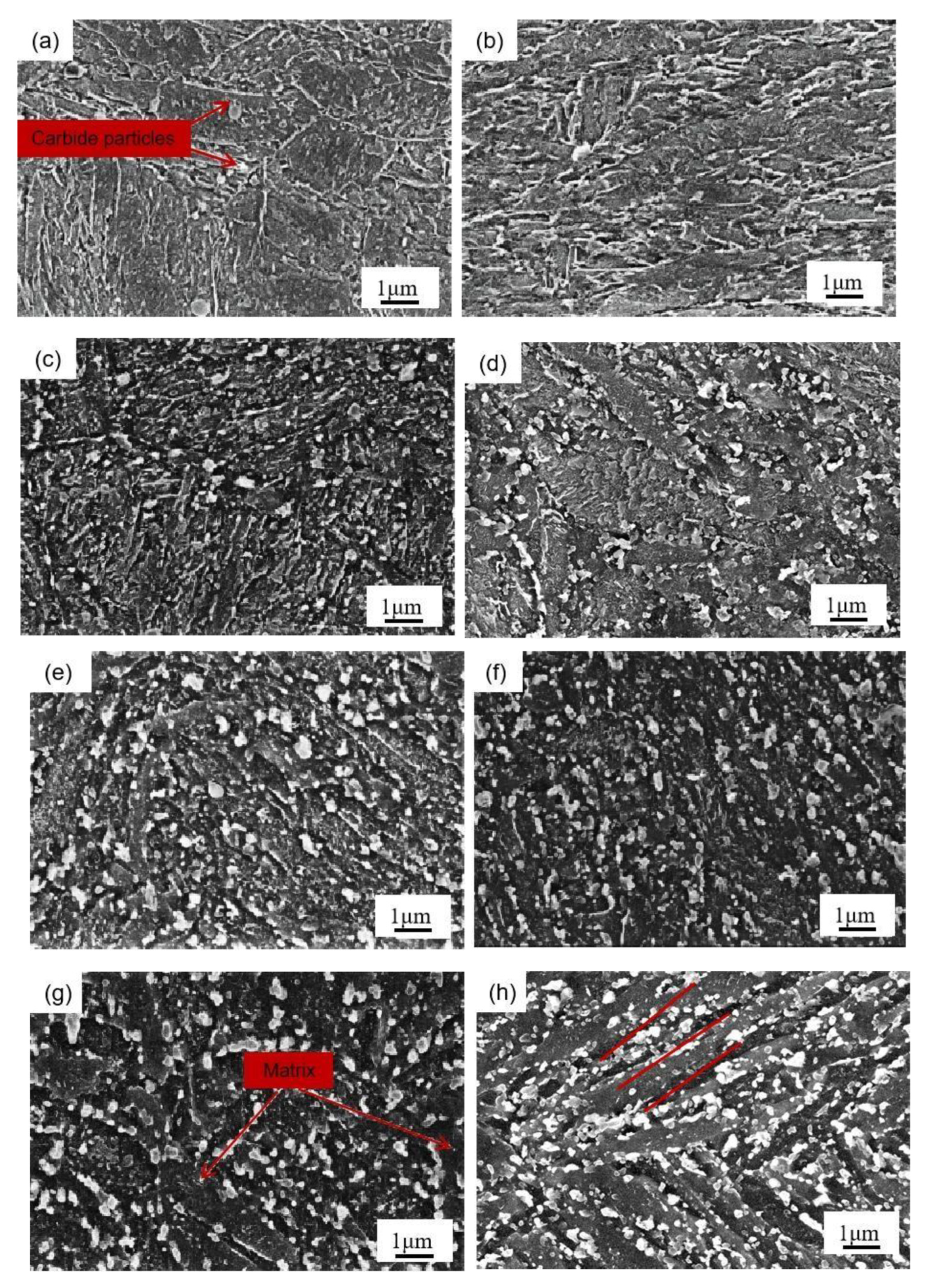
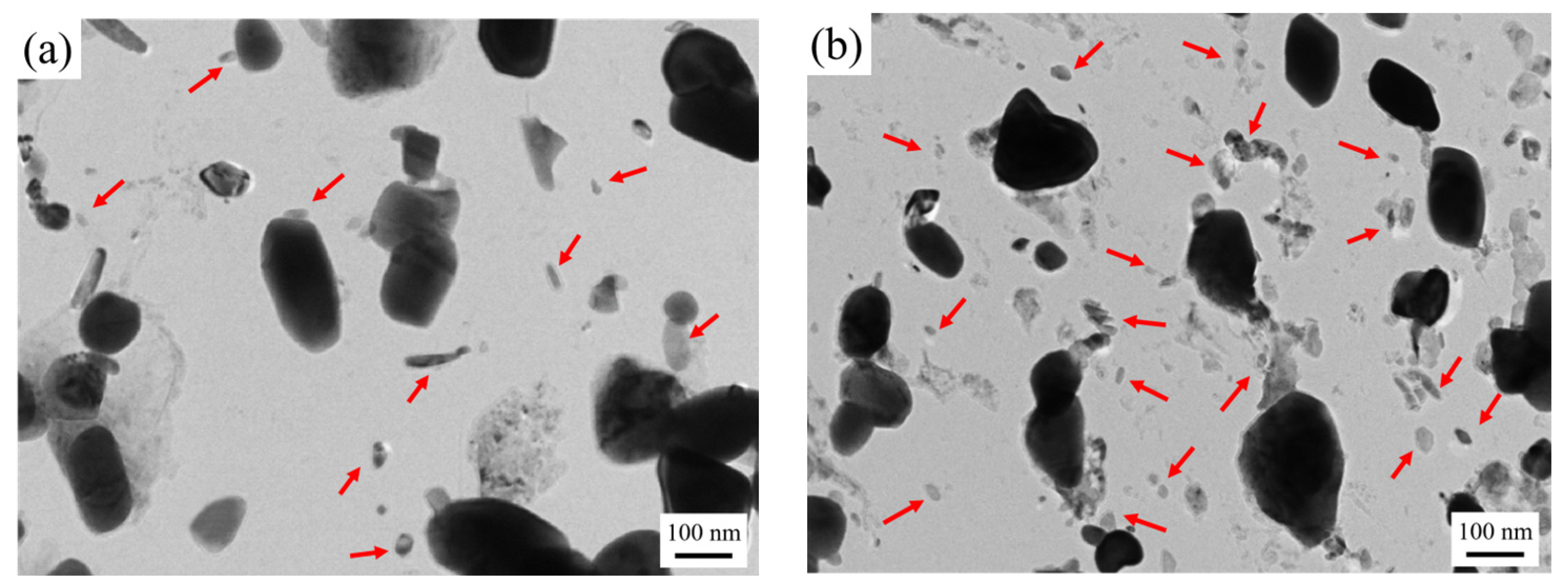
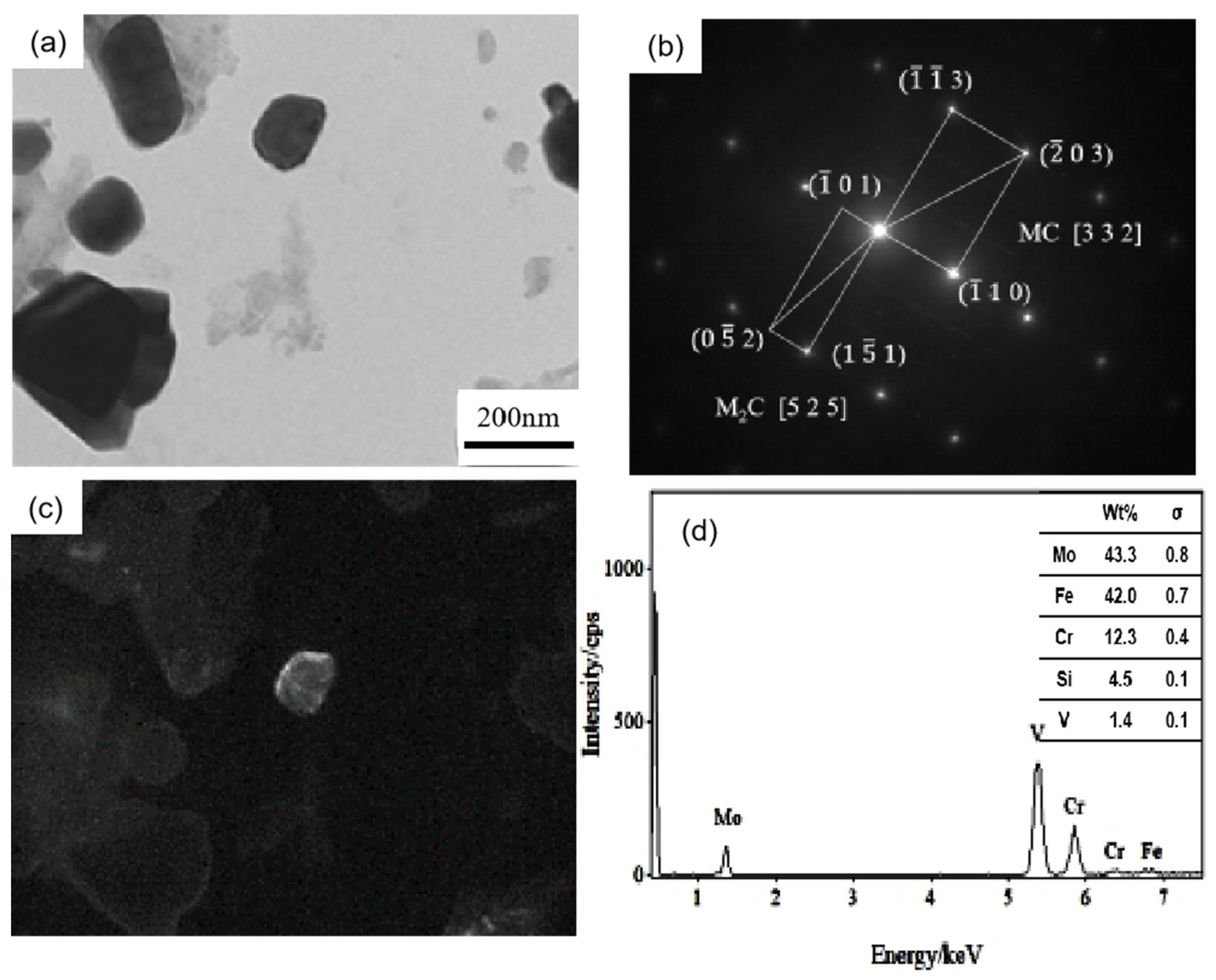
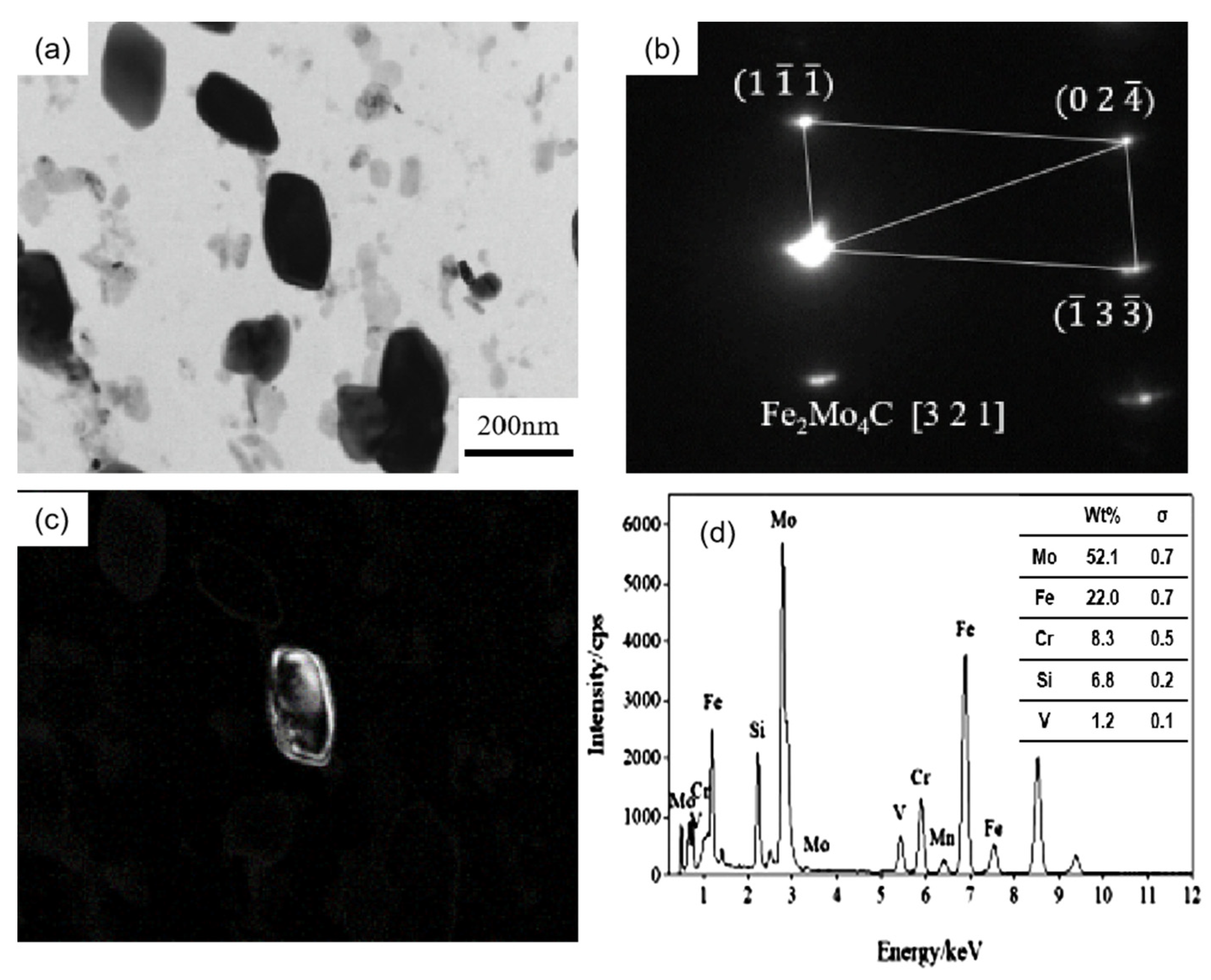
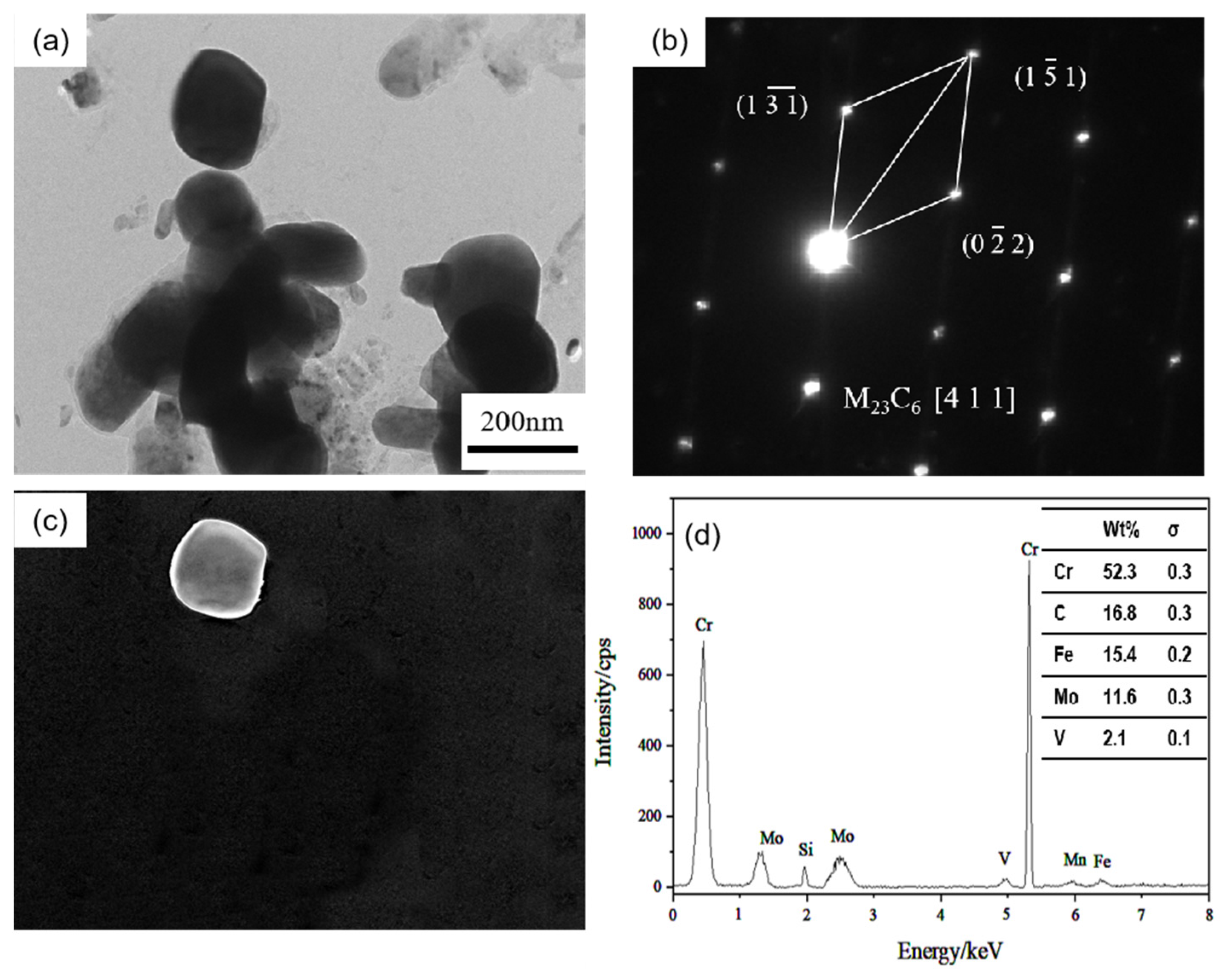
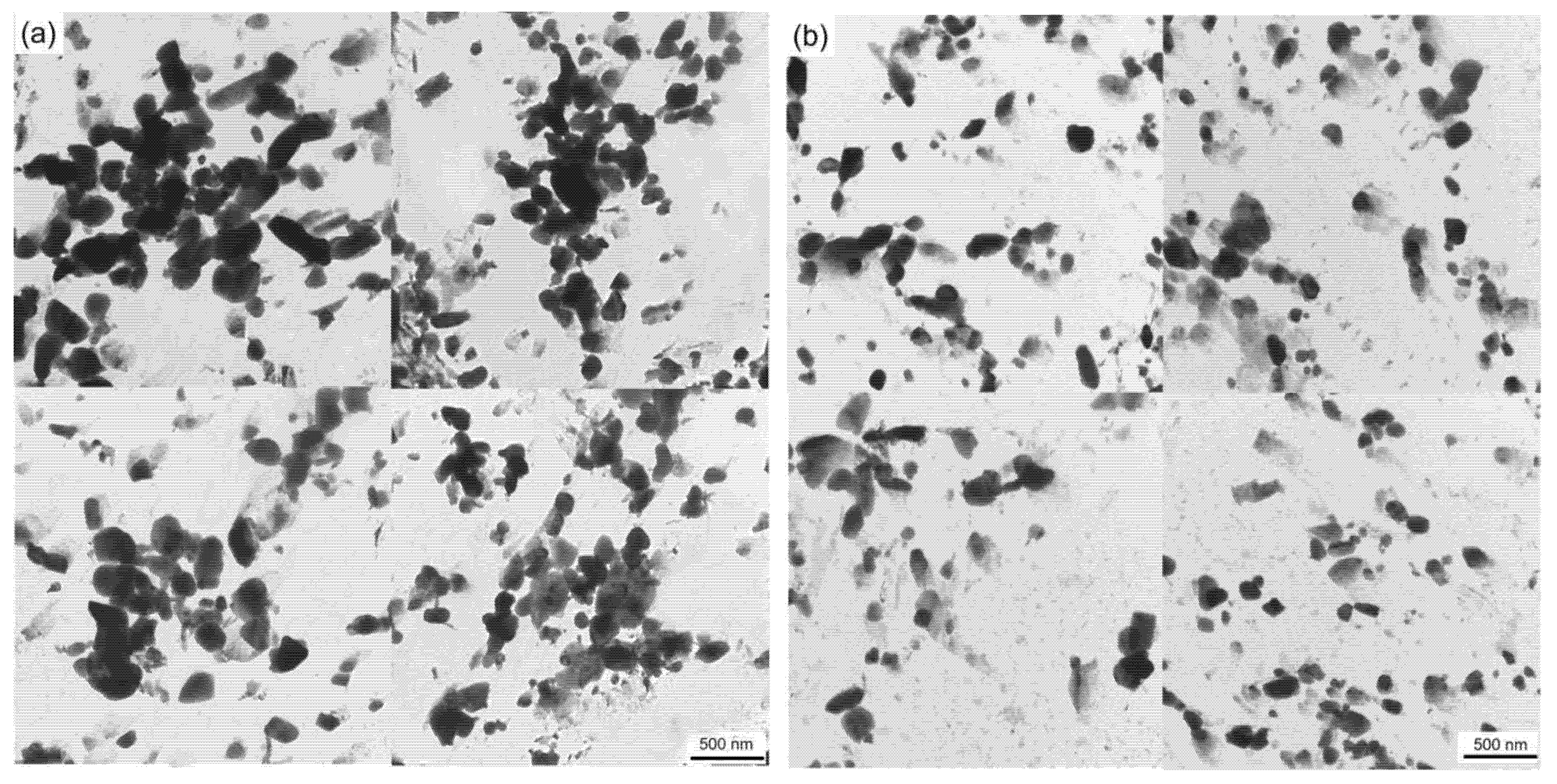

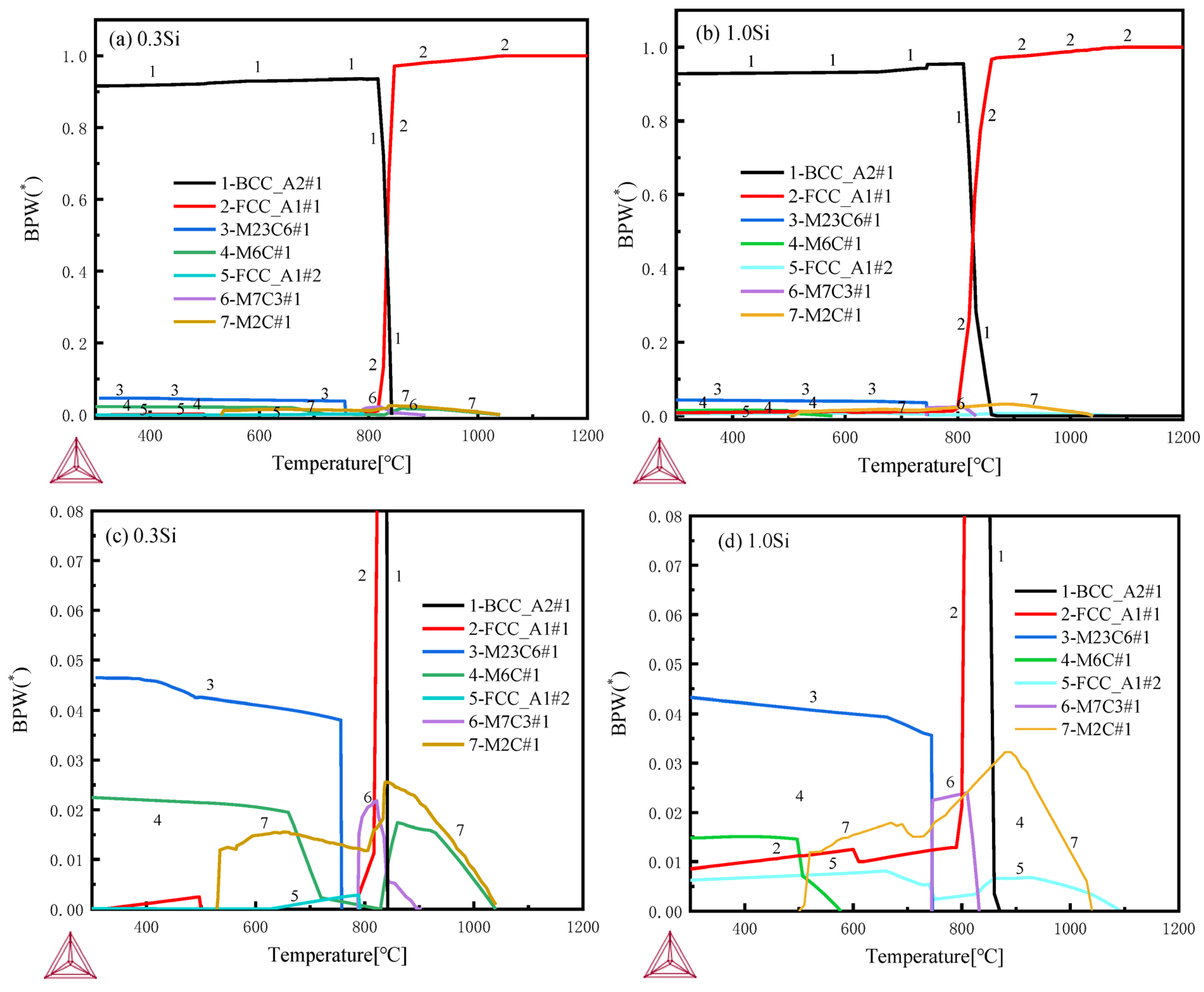

| Steel | C | Si | Mn | Cr | Mo | V | S | P | Fe |
|---|---|---|---|---|---|---|---|---|---|
| 0.3 Si | 0.32–0.40 | 0.30 | 0.51 | 3.01 | 2.0–2.6 | 0.40–0.70 | 0.004 | 0.014 | Bal. |
| 1.0 Si | 0.32–0.40 | 1.00 | 0.50 | 2.99 | 2.0–2.6 | 0.40–0.70 | 0.009 | 0.020 | Bal. |
| Steel | Size Range of Carbides/nm | Percentage | Types of Carbides |
|---|---|---|---|
| 1–100 | 39% | MC, M2C | |
| 0.3 Si | 100–200 | 27% | M2C, M6C, M23C6 |
| 200–400 | 34% | M6C, M23C6 | |
| 1–100 | 73% | MC, M2C | |
| 1.0 Si | 100–200 | 23% | M2C, M6C |
| 200–400 | 4% | M6C, M23C6 |
Disclaimer/Publisher’s Note: The statements, opinions and data contained in all publications are solely those of the individual author(s) and contributor(s) and not of MDPI and/or the editor(s). MDPI and/or the editor(s) disclaim responsibility for any injury to people or property resulting from any ideas, methods, instructions or products referred to in the content. |
© 2023 by the authors. Licensee MDPI, Basel, Switzerland. This article is an open access article distributed under the terms and conditions of the Creative Commons Attribution (CC BY) license (https://creativecommons.org/licenses/by/4.0/).
Share and Cite
Li, L.; Cai, Z.; Wu, X. Effect of Silicon on Thermal Stability of 4Cr3Mo2V Hot-Work Die Steel. Metals 2023, 13, 100. https://doi.org/10.3390/met13010100
Li L, Cai Z, Wu X. Effect of Silicon on Thermal Stability of 4Cr3Mo2V Hot-Work Die Steel. Metals. 2023; 13(1):100. https://doi.org/10.3390/met13010100
Chicago/Turabian StyleLi, Ling, ZhuWen Cai, and XiaoChun Wu. 2023. "Effect of Silicon on Thermal Stability of 4Cr3Mo2V Hot-Work Die Steel" Metals 13, no. 1: 100. https://doi.org/10.3390/met13010100





